February and it’s not yet quite spring in Amsterdam. Soon, the buds in the rose garden in Vondelpark will start to blush pink and yellow; the leaves on the trees surrounding the lake will begin to shimmer with silver and green. Soon, at least in a normal year, people will gather again at the bandstand and the Blauwe Theehuis, the blue teahouse, in this elegant 19th-century park named after the poet Joost van den Vondel, and the diagonal paths that cross the museum quarter between the Rijksmuseum and the Concertgebouw – once a region of small farms and market gardens – will be filled with conversation and bicycles again.
But our focus lies not in the 19th-century city – nor the 20th century with the Anne Frank House beside the Westerkerk – but rather in the old medieval centre of Amsterdam. I should be there now, conducting a walking tour for English and Dutch readers around the canals and overlooked alleyways that inspired my latest adventure novel, The City of Tears. I should be explaining how, in the bloody aftermath of the St Bartholomew’s Day Massacre in Paris in August 1572, my imaginary first family, the Jouberts, flee persecution to the city of tears itself, Amsterdam, to build a new life for themselves.
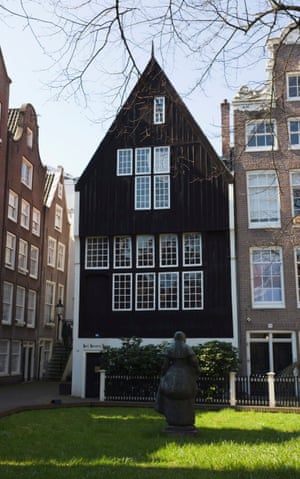
But of course, I’m not. I’m at my desk in Sussex, where I have been for 11 months, dreaming of colour and light. But now more than ever – when we are all imagining elsewhere – we can still visit other places in the pages of a book. In April 2019, I lived at 303 Spuistraat, on a visiting writers’ fellowship awarded by the Dutch Literature Foundation, to research my book. Every day, with notebook and my old maps, I set out to discover the Amsterdam my characters would have discovered. Historical novelists must be detectives and archaeologists, always seeking to find the hidden history of the city beneath our feet. Layer upon layer. So, for several weeks, I walked the canals and streets, imprinting the Amsterdam of 1572, 1578, 1584 in my mind, stripping out the modern buildings, shops and neon lights.
And the old Amsterdam is everywhere, if one looks hard enough and high enough. History and dates are imprinted on the keystones on the buildings, in the names of the streets, the curve of a wall, in the chapels and dykes and waterways, in the tiles on the walls. In the days before street numbers, houses were distinguished by tiles – a stork with a baby showed where the midwife lived, a man with sacks of grain was the home of a rich merchant, an open book meant a printer.
There are some 62 miles of canals in Amsterdam. The grand canals – including Prisengracht, Keizersgracht and Herengracht, where the grandest 17th-century houses stand – were designated a world heritage site by Unesco in 2010. The fourth grand canal is Singel, which was dug in 1420 as a moat to surround the medieval city, and it is here that our tour begins. In 1538, Cornelis Anthonisz, map maker and artist, painted an astonishing bird’s-eye-view map of the 16th-century city.
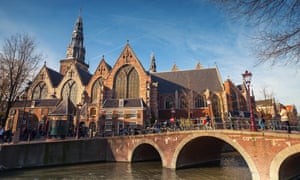
From Singel, we’ll head east to Spui. Once a body of water forming the southern boundary to the city, it’s now the book quarter and home to the American Book Center and the Athenaeum, with its red-and-white awning. Tourists flock to have their photos taken beside the statue, “Het Lieverdje” (the “Little Darling”), a kind Dutch Artful Dodger, who stands opposite the oldest brown cafe in Amsterdam, Cafe Hoppe. Dating from 1670, and originally a jenever (gin) distillery, it became celebrated as a meeting place for activists and intellectuals and artists.
But look closer and you’ll find one of the hidden jewels of Amsterdam, the Begijnhof. Founded in 1346 as a lay religious sisterhood, it’s now a private residence for single women but open to the public. A beautiful tiled passageway leads to elegant gardens and the statue of a Beguine in her distinctive headdress, the falie, stands beside the church. The Begijnhof is where the 16th-century story of The City of Tears begins, with an old secret and a murder. After the “Alteration” on 26 May 1578, when Amsterdam passed from 40 years of Catholic rule into Calvinist hands in the space of one long afternoon, the chapel was confiscated and later given to English and Scots Presbyterians, hence the inscription of 1607 above the door. Most of the houses surrounding the gardens date from the 17th and 18th centuries, but tucked away in the south-west corner is Het Houten Huis, one of only two surviving wooden houses in Amsterdam, which predates the 1521 ban after devastating fires in the 15th century destroyed much of old Amsterdam.
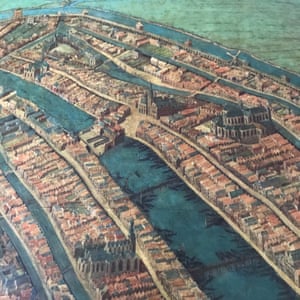
Leaving the Begijnhof by the public entrance into a network of narrow alleyways, we’ll see the Amsterdam Museum to our left – a brilliant resource for historical research and once one of the city’s orphanages. We’re heading towards Kalverstraat – now, as in the 16th century, a major shopping street (more Oxford Street than Knightsbridge!) and a far cry from the elegant independent shops of De Negen Straatjes (the Nine Streets) in the central canal ring and Jordaan, just to the west. Some say the name Jordaan comes from jardin, the name Huguenot refugees gave to the green gardens outside the city walls where they were allowed to settle. It’s possible.
We’re walking north now towards Dam Square, where the earliest inhabitants settled from 1125 on the banks of the Amstel. When the river was damned in 1222, and the population was growing, the contraction of these two words gave this upstart fishing settlement its name: Amsterdam.
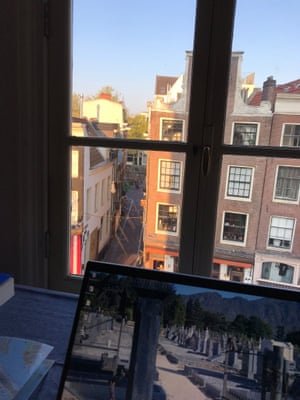
In the 16th century, the huge, open square was known as Plaats. Here is Nieuwe Kerk, built in 1645, and the 17th-century Koninklijk Palace, which replaced the older Stadhuis, as well as the famous Grand Hotel Krasnapolsky and the obelisk commemorating the Dutch women and men who died during the second world war. It is in Plaats, under the stone colonnades of the old town hall, that my imaginary characters stand witness to history during the Alteration.
Next, we’ll go to Oudezijds Voorburgwal and the oldest quarter of the city, De Wallen, which today incorporates the red-light district. At street level are the working premises of window prostitutes and sex shops and museums, a few coffee shops and plenty of bars (though there are plans in 2021 to move this oldest profession out of the city centre). But if you look up, you’ll see the history of the buildings: 16th– and 17th-century keystones, rows of tall houses with their distinctive gables – bell gables, plus spout, neck, clock and step gables. The houses – many with winches – tilt slightly forward, as if bowing to one another from across the canal. There are red shutters everywhere and the colours of the Amsterdam flag, red, white and black, are painted on walls and alleyways.
This is where the Oude Kerk (the Old Church) is to be found. Known as Sint-Nicolaas in the 16th century (before the 19th-century Basilica was built overlooking the harbour and before the New Church became more attractive to Calvinist wives), it stands on the site of a 13th-century chapel, though most of the building dates from the 14th century. Sint Nicolaas is the patron saint of Amsterdam itself and of seafarers. The 17th-century tower contains a 47-bell carillon, which echoes out over the water every quarter of an hour, competing with the shrieking of the gulls following the herring fleets. Rembrandt was married here, going through the famous red door into the sacristy with its inscription: “Marry in Haste, repent at Leisure”.
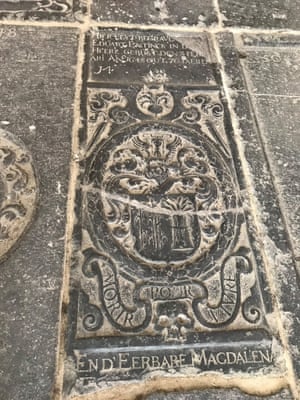
The Oude Kerk was looted in the 1566 “Iconoclasm” – when Calvinists destroyed icons, glass, treasures, the altar and statues – so is very plain inside. But if you look down, you will see engraved tombstones. This, joyously, is said to be where the phrase “stinking rich” comes from. In a city built on water, with few cemeteries within the city walls, the richest people paid to be buried beneath the nave. When the temperatures rose, so did the stink of decomposing bodies…
We’re continuing north towards the harbour into Zeedijk, a narrow street at the top of the town, once part of the 13th-century fortifications. The other surviving wooden house is at No 1. Now a popular bar, In ‘t Aepjen (literally, “in the monkeys”) was a sailors’ boarding house in the 1550s. Its name is said to come from the custom of bartering exotic animals in lieu of rent. Again, it is possible… Home now to Chinatown, Zeedijk still has, on a normal Saturday night, the swaggering feel of the harbour quarter.
At the eastern end is Nieuwmarkt, the main market square since the 15th century. It’s here the Jouberts will settle, in the shadow of the hated Grey Friars monastery. Destroyed during the Alteration, the monastery is on Bloedstraat, whose name is said to derivve from the fact that there was a torture chamber – a “blood chamber” – within the monastery walls.
One of Amsterdam’s oldest surviving buildings, Schreierstoren, the Tower of Tears, is way up to the left on the harbour. It’s here that wives and daughters and lovers waved goodbye to men settling sail in the service of the Dutch East India Company. A plaque on the wall commemorates the departure of Henry Hudson to the New World in 1609.
But Nieuwmarkt is dominated by another defensive tower, De Waag tower. Built in 1488, and previously known as Sint Antoniespoort, it was once the main gate into Amsterdam from the east. It’s now a cafe, but was used as a weigh house in the 17th century and in the time of The City of Tears was home to various guilds – including the painters, the masons and the surgeons. It was these last who, in 1632, commissioned Rembrandt’s celebrated The Anatomy Lesson of Dr Nicolaas Tulp.
Slipping into Oudezijds Achterburgwal, past the Hash Marihuana & Hemp Museum and through the diamond quarter, jumping across the tram lines on Rokin, we’re heading for the Munttoren on the Amstel, once the city’s royal mint. From there, it’s a stone’s throw to Singel. We’re nearly back to where we started.
It’s still February and I am still in Sussex. But in my mind’s eye, it’s April again. There will be a riot of tulips in the Bloemenmarkt, the floating flower market. The bells of the Lutheran church will be ringing. And, for a while at least, at the end of our walking afternoon, I think I can see the lights under the arches over the canals coming on, bridge by bridge, as dusk falls over Amsterdam.
• The City of Tears by Kate Moss is published by Mantle (£20). To buy a copy for £17.40, see guardianbookshop.com. For information about upcoming guided tours of Amsterdam see tripsmiths.com





